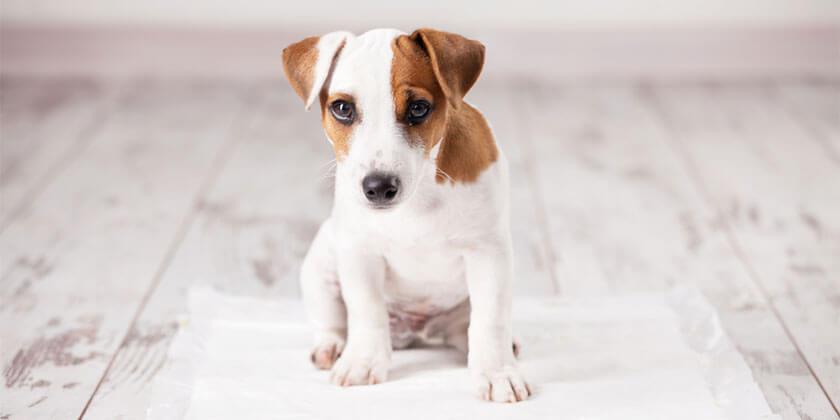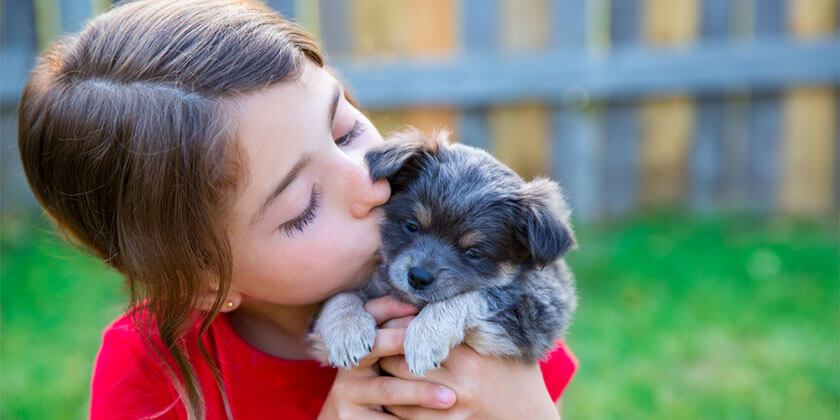How to toilet train your puppy

Dogs are social animals that truly thrive when they’re allowed to interact properly with the family, and often this means spending time indoors. And if they’re living indoors, they need to be toilet trained.
You can start toilet training your puppy from the time they arrive at home. The best option for training dogs is positive reinforcement, and primarily this method requires patience and willingness to guide your little canine family member until they are housebroken.
Anticipating your puppy’s need to eliminate
Every puppy has a unique elimination schedule, but most puppies need to go to the toilet after they wake up from a nap, after they have a meal, after they have a big drink of water, and during or after a play session. Encourage your puppy to go right before your bedtime so they’re less likely to need to go during the night.
Puppies may need to be encouraged to eliminate as often as every 30 to 45 minutes when they’re not asleep, until they’re housebroken. A regular eating schedule will make it easier to anticipate just when to give your puppy access to their toilet training area. The puppy’s digestive system deals with food quickly, so your puppy might need to go to the toilet anywhere from five to 30 minutes after eating.
Common toileting signals include sniffing the ground while walking in a circular pattern, squatting, or wandering off. Sometimes your puppy will wake in the middle of the night and whine in their bed, which could also suggest they need to go. Standing at the door or scratching the door could also be a strong signal that they need to be taken out to go.
In the early days of toilet training, you’ll need to watch your puppy carefully so you can anticipate them and quickly move them to a designated area. This might include following them around during play or keeping them close after a meal to avoid any unexpected toileting accidents in the house.
“Keep in mind most puppies are not fully house trained until they reach six months, so be patient and consistent as your puppy learns this vital skill.”
Choose a designated area
Puppies instinctively relieve themselves in a place that smells and feels familiar to them, which is why puppies that haven’t completed toilet training will go to the toilet in the same place. A designated area encourages the puppy to feel safe and makes it easier for you to toilet train him or her. The familiar scent of the place can act as a trigger for your puppy to eliminate.
If you live in a house with a garden, it’s easy to take your puppy outside at regular intervals and let them go in the garden. If you live in an apartment without a garden, consider dedicating a space in your toilet or an unused room for your puppy’s toilet training. Lay out newspapers for the toilet training program both to signal to them where they should be relieving themselves and to avoid having to clean up messy floors.

Move your puppy quickly
Once you’ve noticed the toileting signals, you can encourage your puppy to follow you to the designated area, whether inside or outside in the garden. Alternatively, you can simply pick up your puppy and taxi them to the designated area if you don’t think they are moving quickly enough. For bigger breeds of dogs, use the collar to guide your dog to the designated area. You may need to carry your puppy in this way for the first month or more, until they learn to go to the right place without your help.
Get into the habit of using set commands and praises to guide your puppy as they learn. For example, you can use ‘toilet’, ‘go now’, or some other short phrase to communicate what you want them to do. Eventually they will come to associate the phrase with the activity and they will have little trouble understanding your command.
Establish a routine
Consistency is the key to successful toilet training, and this applies to set times for meals (rather than free feeding) every day, using the same place and commands when your puppy is eliminating, and regular intervals for taking your puppy to their designated area and encouraging them to go.
Use positive reinforcement
Positive reinforcement works best with puppies. Make sure you praise and pat them enthusiastically immediately after they have gone to the toilet. Food treats are less suitable for toilet training because of the risk of overfeeding. Avoid angry reprimands or punishment when your puppy makes a mistake, as this can lead to confusion and fear from the puppy, they might decide to go to the toilet wherever they like when you’re not at home to reprimand them.
Puppies are still developing the necessary muscle control, so mistakes are inevitable from time to time. If they do make a mistake, the best thing to do is to ignore it. Say nothing and move your puppy to the designated toileting area if they’re still going, so they associate the activity with the place. If they’re nearly finished, allowed them to finish without saying anything. It’s best not to make a big fuss when they get it wrong and praise them when they do get it right.
Use baby gates and other obstructions to keep your puppy away from places they’re attracted to, and clean up with an enzymatic cleaner to remove the smell, as ammonia-based products can attract the puppy back to the same area.

Toilet training in your absence
If you need to leave your puppy alone at home at times and your puppy usually goes to the toilet outside in the garden, you can keep training them by confining them to a suitable space that includes their den and a toilet area. Cover the entire area with paper. At first, your puppy will go anywhere and everywhere, and you’ll need to clean up when you get home.
After a while, they’ll show preference for going in a specific area, so keep narrowing the paper-covered space until you only need to set down a few sheets. Sometimes they will pee outside the paper-covered area; if so, expand the area again until they use the paper and not the floor. Eventually, you will be able to set down just a few sheets of paper or show them to a specific yard area, and your dog will happily go there every time.
11 May 2016